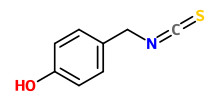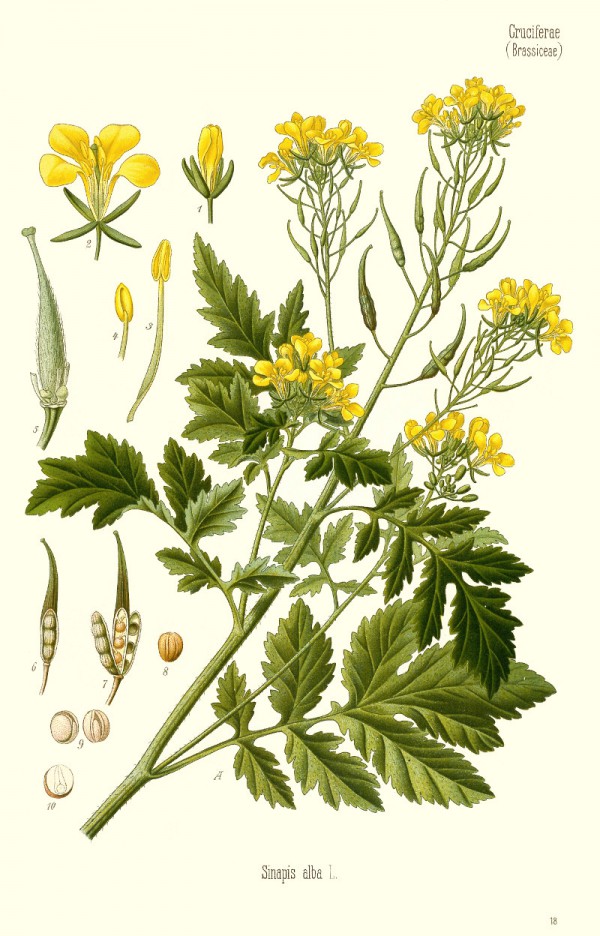Sinapis alba L. - Brassicaceae - white mustard, Weißer Senf
Annual herb, up to 1m high, native to Europe, Mediterranean; basal leaves hairy, layrate, irregularly incised, with large terminal lobe; upper leaves ovate or oblong-ovate, coarsely dentate; flowers bright yellow; fruit a bristly pod with 4-8 yellowish seeds.
„The seeds are used for the manufacture of table mustard and also for the extraction of oils, which are used for cooking and making soap and mayonnaise. The species is a cosmopolitan, naturalized weed.“
http://www.efloras.org/florataxon.aspx?flora_id=2&taxon_id=200009674
Young plants contain more glucobrassin (3-indolylmethyl-glucosinolate, 47µg/g fresh weight) and methoxy glucobrassicin (4-methoxy 3-indolylmethyl-glucosinolate, 64µg/g) than sinapin.
[Distribution of 4-methoxy-3-indolylmethyl-glucosinolate (4-methoxy-glucobrassicin) in Brassicaceae., Bäuerle, R., Wagner, H., Schraudolf, H., Experientia, Vol.42(1), 1986, 86-86]
„In the mustard paste, sinalbin is hydrolyzed by myrosinase to p-hydroxybenzyl isothiocyanate (I), sinapine acid sulfate and glucose. It was found that the three decomposition products were formed from sinalbin, and two of them were isolated from the mustard paste and identified as p-hydroxybenzyl alcohol (II) and di-(p-hydroxybenzyl)-disulfide (IV), respectively. II was the major product and IV was a minor product.“
[Studies on the decomposition of sinalbin., Kawakishi, S., Muramatsu, K., Agricultural and Biological Chemistry, Vol.30(7), 1966, 688-692]
„p-Hydroxybenzyl isothiocyanate is the constituent responsible for both flavour and aroma in white mustard. This isothiocyanate is not present in the free state as such but is produced as a result of hydrolysis of sinalbin present in the mustard.“
[Volumetric determination of p‐hydroxybenzyl isothiocyanate in sinalbin (p‐hydroxybenzylglucosinolate) and in white mustard seed (Sinapis alba L)., Raghavan, B., Shankaranarayana, M.L., Nagalakshmi, S., Natarajan, C.P., Journal of the Science of Food and Agriculture, Vol.22(10), 1971, 523-525]
 4-hydroxybenzyl isothiocyanate
4-hydroxybenzyl isothiocyanate
„4-Hydroxybenzoylcholine has been identified and found to be one of the quantitatively dominating choline esters in seed extracts of S. alba. The identity of the new natural product has been confirmed by comparison with synthetic reference compounds. Several different choline esters are present in this plant but in extracts of seedlings, leaves, and inflorescences they are not so quantitatively dominating as in seeds.“
[4-Hydroxybenzoylcholine: A natural product present in Sinapis alba., Clausen, S., Olsen, O., Sørensen, H., Phytochemistry, Vol.21(4), 1982, 917-922]
„Sinalbin occurs as a major glucosinolate in seeds of Sinapis alba L., in various mustards and other food products. The degradation products were identified and quantified by analysis based on a developed SFC method using a bare silica column. Determinations comprised transformation products of sinalbin, produced both during degradation of isolated sinalbin, and during autolysis of meal from S. alba seeds. The conditions in the developed SFC method were used as basis for the preparative SFC procedure applied for isolation of the components prior to their identification by nuclear magnetic resonance (NMR) spectroscopy. Myrosinase catalysed sinalbin hydrolysis resulted in the reactive 4-hydroxybenzyl isothiocyanate as an initial product at pH values from 3.5 to 7.5 whereas 4-hydroxybenzyl cyanide was one of the major products at low pH values. 4-Hydroxybenzyl isothiocyanate was found to disappear from the aqueous reaction mixtures in a few hours, as it reacted easily with available nucleophilic reagents. 4-Hydroxybenzyl alcohol was found as the product from reaction with water, and with ascorbic acid, 4-hydroxybenzylascorbigen was produced.“
[Supercritical fluid chromatography as a method of analysis for the determination of 4-hydroxybenzylglucosinolate degradation products., Buskov, S., Hasselstrøm, J., Olsen, C.E., Sørensen, H., Sørensen, J.C., Sørensen, S., Journal of biochemical and biophysical methods, Vol.43(1), 2000, 157-174]
„Allyl isothiocyanate (AITC) and phenethyl isothiocyanate (PEITC) were isolated from Sinapis alba L. seeds and their effects against Dermatophagoides farinae and D. pteronyssinus were evaluated using the impregnated fabric disk method. The LD50 values of their compounds and derivatives were then compared with those of a commercial acaricide, benzyl benzoate. On the basis of the LD50 values against D. farinae, PEITC (0.21 μg/cm2) was the most toxic, followed by benzyl isothiocyanate (0.55 μg/cm2), phenyl isothiocyanate (1.09 μg/cm2), butyl isothiocyanate (1.24 μg/cm2), and AITC (1.36 μg/cm2).“
[Acaricidal Constituents Isolated from Sinapis alba L. Seeds and Structure− Activity Relationships., Lim, J.H., Kim, H.W., Jeon, J.H., Lee, H.S., Journal of agricultural and food chemistry, Vol.56(21), 2008, 9962-9966]

Köhler, F.E., Medizinal Pflanzen, vol.3, t.18 (1890)
http://www.plantillustrations.org/species.php?id_species=949542
Sinapis alba, © Rolf Marschner (2017),
www.botanische-spaziergaenge.at
